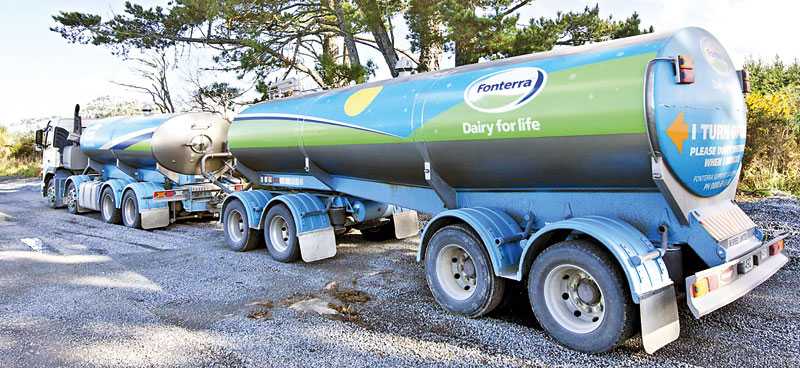Sunday Apr 20, 2025
Sunday Apr 20, 2025
Thursday, 11 February 2021 00:00 - - {{hitsCtrl.values.hits}}

Fonterra, a New Zealand co-operative producing milk, is one of the largest co-operative brands in the world, same as Amul India
 Features of Co-operatives
Features of Co-operatives
A detailed historical background and evolution of the co-operative business was discussed in my first article on the subject published before. A few readers enthusiastic on the subject and would prefer to dig deep into this unique business model which is not State or privately owned business.
A co-operative is an autonomous association of persons united voluntarily to meet their common economic, social, and cultural needs and aspirations through a jointly owned and democratically controlled enterprise.
Hence, co-operative is a member-based people’s business model. At least seven members are required to form a co-operative. Therefore, it is collective effort rather than individualistic approach. Further, co-operative members have one vote at the general body irrespective of number of shares he or she invested in the co-operative. This is a significant factor that demarcate the co-operative from privately owned businesses where privately owned businesses representation is largely based on the number of shares owned in the entity.
The International Co-operative Alliance (ICA) has published seven Co-operative Principles in 1995 at Manchester, United Kingdom. These principles are,
1. Voluntary and open membership: Co-operatives are voluntary bodies, open to all individuals able to be part and willing to accept the responsibilities of membership, without gender, social, racial, political or religious discrimination.
2. Democratic member control: Co-operatives are democratic institution controlled by members, who actively participate in setting their policies and making decisions. Individuals serving as elected representatives are accountable to the membership. In primary co-operatives, members have equal voting rights (one member, one vote policy).
3. Member economic participation: Members contribute equitably to, and democratically control, the capital of their co-operative. At least part of the member’s capital is usually the common property of the co-operative. Members usually receive limited compensation on capital subscribed as a condition of membership. Members allocate surpluses for any of the following purposes: developing their co-operative, setting up reserves, part of which at least would be indivisible; benefiting members in proportion to their transactions with the co-operative; and supporting other activities approved by the membership.
4. Autonomy and independence: Co-operatives are autonomous, self-help organisations controlled by their members. If they enter into agreements with other organisations, including governments, or raise capital from external sources, they do so on terms that ensure democratic control by their members and maintain their co-operative autonomy intact.
5. Education, training, and information: Co-operatives provide education and training for their members, elected representatives, managers, and employees so they can contribute effectively to the development of their co-operatives. Co-operatives inform the public particularly to young people and opinion leaders, policy makers about the nature and benefits of co-operation.
6. Co-operation among co-operatives: Co-operatives serve their members most effectively and strengthen the co-operative movement by working together through local, national, regional and international structures. Co-operative to Co-operative (C to C) business is always welcome and strengthened.
7. Concern for community: Co-operatives work for the sustainable development of their communities through policies approved by members.
In addition to the above seven principles, co-operatives are based on the values of self-help, self-responsibility, democracy, equality, equity, and solidarity. Honouring the founders of the movement, co-operative members believe in the ethical values of honesty, openness, social responsibility and caring for others.
You may understand that, adhering above principles, values and ethics make co-operative business is unique from state or private enterprises and more appealing towards perfect social enterprise focused on development of their members or the community they serve. However, one should not be misunderstand it as Non-Government Organisation (NGO) or not for profit industry. Co-operatives are profit-making entities.
Types of co-operatives
There are various types of co-operatives in the world. Sri Lanka consists of financial co-operatives (thrift and credit co-operative societies, co-operative rural banks, etc.), multipurpose co-operative societies (MPCS, there are about 300 in Sri Lanka), agriculture based co-operatives (tea smallholders co-operatives, coconut producers co-operatives, etc.), health co-operatives (hospital co-operatives in Galle, Kurunegala, etc.), institutional/service co-operatives (Postal Department Employees Co-operative, Public Sector Employees Co-operative, Education Employees Co-operative Society – EDCS famously known as “Gurugedera”), etc.
Co-operatives can be three tier: Primary co-operatives build up from individual members; secondary co-operatives consist of primary co-operatives as members (district co-operative councils, consist of primary co-operative societies of the particular district); tertiary or national federation co-operative society consist of secondary level co-operative societies as members. The apex organisation for co-operatives in Sri Lanka is the National Co-operative Council of Sri Lanka (NCCSL).
In India and advanced economies, there are worker co-operatives where members are labours or skilled people who serve under their co-operative brand. Uralungal Labour Contract Co-operative Society (ULCCS) is India’s oldest worker cooperative. Located in Kozhikode Kerala, it was established in 1925. The Uralungal Labour Contract Co-operative Society has about 1,415 members. The team has completed more than four thousand works so far and one road and bridge construction project exceeded Indian Rs. 10 billion.
By respecting the co-operative principles, values and ethics, people can make any type of co-operatives such as Palmyra Toddy Producers Co-operatives in Jaffna complying with the law of the country.
Notable co-operative brands
In Sri Lanka, we have brands like SANASA and CRB (Co-operative Rural Banks). In fact, brand ownership is collective and people’s perception on brands are varied. Internationally we can find exceptional cases such as IFFCO, Amul, Fonterra, Credit Agricola, Rabo Bank, Desjardin, etc.
The Indian Farmers Fertiliser Cooperative Ltd. (IFFCO) is one of India’s biggest co-operative societies, which is wholly owned by Indian co-operatives. Founded in 1967 with just 57 co-operatives, today it is an amalgamation of over 36,000 Indian co-operatives with diversified business interests ranging from general insurance to rural telecom apart from core business of manufacturing and selling fertilisers.
Fonterra, a New Zealand co-operative producing milk, is one of the largest co-operative brands in the world, same as Amul India. Amul is an Indian dairy co-operative society, based at Anand in the Indian state of Gujarat. Formed in 1946, it is a co-operative brand managed by a co-operative body, the Gujarat Co-operative Milk Marketing Federation Ltd. (GCMMF), which today is jointly owned by 3.6 million milk producers in Gujarat. Amul spurred India’s White Revolution, which made the country the world’s largest producer of milk and milk products.
Crédit Agricole Group (France), sometimes called “The Green Bank” due to its historical ties to farming, is the world’s largest co-operative financial institution. It consists of a network of Crédit Agricole local banks, the 39 Crédit Agricole regional banks, and a central institute, the Crédit Agricole. In 1990, it became an international full-service banking group.
Likewise, Rabobank is a Dutch multinational banking and financial services co-operative headquartered in Utrecht, Netherlands. It is a global leader in food and agriculture financing and sustainability oriented banking. The group comprises 89 local Dutch Rabobanks, a central organisation and many specialised international offices and subsidiaries. Food and agribusiness constitute the primary international focus of the Rabobank Group. Rabobank is the second-largest bank in the Netherlands in terms of total assets.
The Desjardins Group is a Canadian financial services co-operative and the largest federation of credit in North America. Alphonse Desjardins founded it in 1900 in Lévis, Quebec. As of 2017, Desjardins Group consists of 293 local credit unions operating 1,032 points of service and serving more than seven million members and clients, mostly in the provinces of Quebec and Ontario.
 In advanced economies
In advanced economies
The co-operative economy comprises over 10% of the Gross Domestic Product in four countries in the world (New Zealand (20%), Netherlands (18%), France (18%) and Finland (14%). Countries like USA, Australia, Japan, South Korea and Scandinavian countries have strong co-operative enterprises in various sectors, particularly in agriculture, contributing significantly to national GDP.
Co-operatives can play a major role in developing local economies. Unfortunately, in Sri Lanka, not enough focus and resources have been put into developing the sector. Further, outdated co-operative laws of the country hinder the development of co-operatives. Attention of officials and members to change those in an effective way is lacking. In fact, the importance of this valued model should not to be undermined in the country’s socioeconomic development.
(The writer is a professional in the microfinance and development sector who has served at CEO/Director level in co-operative enterprises. He can be reached via [email protected].)
Discover Kapruka, the leading online shopping platform in Sri Lanka, where you can conveniently send Gifts and Flowers to your loved ones for any event including Valentine ’s Day. Explore a wide range of popular Shopping Categories on Kapruka, including Toys, Groceries, Electronics, Birthday Cakes, Fruits, Chocolates, Flower Bouquets, Clothing, Watches, Lingerie, Gift Sets and Jewellery. Also if you’re interested in selling with Kapruka, Partner Central by Kapruka is the best solution to start with. Moreover, through Kapruka Global Shop, you can also enjoy the convenience of purchasing products from renowned platforms like Amazon and eBay and have them delivered to Sri Lanka.
Discover Kapruka, the leading online shopping platform in Sri Lanka, where you can conveniently send Gifts and Flowers to your loved ones for any event including Valentine ’s Day. Explore a wide range of popular Shopping Categories on Kapruka, including Toys, Groceries, Electronics, Birthday Cakes, Fruits, Chocolates, Flower Bouquets, Clothing, Watches, Lingerie, Gift Sets and Jewellery. Also if you’re interested in selling with Kapruka, Partner Central by Kapruka is the best solution to start with. Moreover, through Kapruka Global Shop, you can also enjoy the convenience of purchasing products from renowned platforms like Amazon and eBay and have them delivered to Sri Lanka.